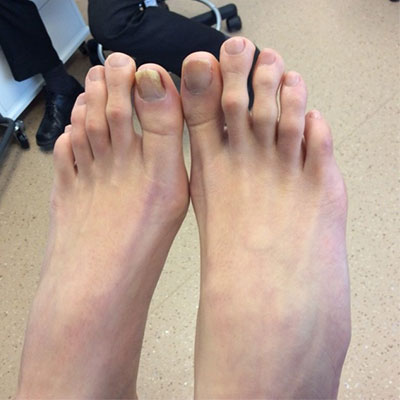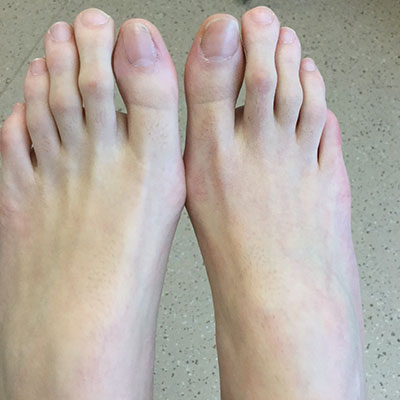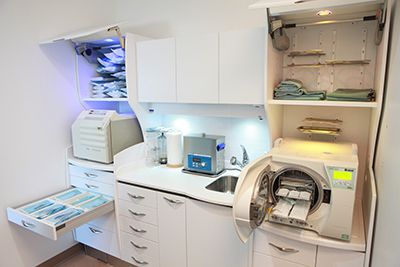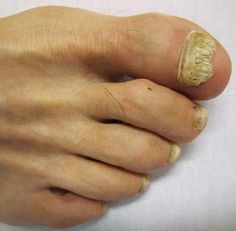Before and After




This 29 years old mother have been affected with a sore, on and off, ingrown toenail on her left big toe for years.
Because her calloused nailfolds were pushing up against both nail sides, the nail got finally detached from the toe. This broke away the natural barrier at the distal end of the nail. Then the fungal micro-organisms got right into the open spaces under each side of her discolored and yellowish nail.
An ingrown toe nail procedure had been performed conservatively enough to preserve the natural outline of her left big toenail and the look of her feet. The immune system of this young lady was strong enough to push away the disfiguring fungal nail infection.
Here is the final picture showing how the appearance of her foot, toe and nail had been nicely preserved. At Ottawa Foot Clinic, we take pride in providing you such good looking and fungus-free end-results!

Like a rusty hinge that makes opening and closing a door difficult, the joint pain and stiffness of arthritis can make it hard to bend or move. While there is no cure, there are plenty of things you can do to slow the progression and relieve symptoms. Thats good news for those who suffer from this condition in their feet and ankles, since there are more than 30 joints in the foot allowing for a wide range of movements. If pain or joint stiffness sets in here, it can make even standing or simply walking difficult.
Although there are many types of arthritis, the most common that affect the feet and ankles include:
Osteoarthritis this is what is known as degenerative, meaning it is caused by wear and tear over time and the natural aging process. A breakdown of the cartilage that cushions the joints leads to inflammation, pain, and sometimes even deformity. This usually occurs slowly over many years.
Rheumatoid arthritis a chronic, autoimmune disease, this type is the result of your body producing substances that attack your joints, damaging the bones, cartilage, and connective tissues. The exact cause is unknown, although it is believed that some people carry the gene which can be triggered by infection or environmental factors.
Posttraumatic arthritis dislocations and fractures from the past can come back to haunt you! This type of the condition can set in and damage the affected joints cartilage even years after the initial injury.
Symptoms of arthritis include swelling, tenderness, redness, warmth to the touch, pain with motion or activity, and joint stiffness. Thats a long list, but believe it or not, with just a few changes, you can not only manage these symptoms, but live a full and active life.
Pain Laser treatments, anti-inflammatory medications or injections, synovial fluid replacement using Hyaluronate Acid (HA) solutions as Synvisc or Neovisc, compressive socks, ankle and foot supports and orthotics are all ways that can provide relief. A switch to a pair of shoes that offer support, flexibility, and are shaped like your foot can make a difference too. Stretching exercises are also beneficial, and although you may experience joint pain with movement, a great way to manage the pain, ironically, is to do just that move! Exercising can do wonders to minimize joint stiffness and pain. Low-impact options are best since they do not put excess stress on your joints. Try swimming or biking, for example.
Of course, if arthritis pain is too much and affecting your quality of life, surgery is also an option. Procedures range from removing osteophytes, replacing damaged cartilage and joints with the newest alternatives to fusion of the bones. Our foot specialists can assess your situation and help you decide the best course of action. If you are suffering from painful joints, call Ottawa Foot Clinic at (613) 595-9700 today. We can help you return to a full and active life, and close the door on joint pain. Come see us at our Ottawa, ON, Canada location, or visit us online.

Tarsal Tunnel Syndrome compresses the Tibial nerve as it travels along the inner leg. This foot condition causes pain and tingling in the ankles, pain radiating up the leg and into the foot, swelling of the heel, electric-like shocks, hot and cold sensations, and even a burning sensation starting at the bottom of the foot and going upward.
Naturally, this condition is most unpleasant and strange. Often patients will feel like their feet dont have enough padding but they dont know why. TTS can be caused by a variety of issues (including benign cysts, varicose veins or tendon sheath Inflammation), but its important for you to come in to Ottawa Foot Clinic and have the problem properly diagnosed and treated. Don’t delay!

Medical Pedicure is nail and foot care provided with a hospital-grade sterilization protocol by trained and qualified foot specialists, doctors of podiatric medicine and chiropodists. Each and every hand and rotative instrument that will touch your foot during your treatment will have been previously sterilized in an ultrasonic device, dried, bagged, and autoclaved in our in-office sterilization centre.
Our advanced foot care or medical-grade pedicure service is ideal for everyone, especially those at risk of cross contamination from a substandard unsanitary nail spa/salon working with infected instrumentation which does not go through an autoclave cycle.
Our trained staff regularly treat patients suffering from different ailments following visits to local unsanitary nail salons. The most common complaints are:
Athlete’s foot or fungal skin infection;
Onychomycosis or fungal nail infection;
Ingrown toenails from poorly cut nails;
Cellulitis or bacterial infection resulting from cuts to skin barrier;
Infection of a pre-existing diabetic ulceration.
Although athlete’s foot is treatable within a few 4-6 weeks with consistent twice-daily application of antifungal creams or foams, treating toenail fungus will require repetitive in-office laser sessions with a specific wavelength to kill the stubborn infesting micro-organisms (this is done over a 6 to 15 month-period). Mild to moderate ingrown toenails may be solved with nail braces to straighten up involuted nails while severe cases may require surgery. Cellulitis and diabetic ulceration at the least requires antibiotic treatment, but in its more serious stages can also result in toe or foot amputation and even death.
Currently, local government authorities are responsible for monitoring and legislating nail salon health standards; unfortunately the rising number of infections being spread suggests there is little being done to protect you.
At Ottawa Foot Clinic, sterilization procedures are of critical importance. We take very seriously our mission to provide you with the highest standards of cleanliness known to our profession.
 Nothing life threatening herejust an annoying, unsightly toenail problem that may have you hiding your feet and not wanting to participate in certain activities. Why go on suffering the embarrassment of thick, yellow, brittle nails, when there is help close by?
Nothing life threatening herejust an annoying, unsightly toenail problem that may have you hiding your feet and not wanting to participate in certain activities. Why go on suffering the embarrassment of thick, yellow, brittle nails, when there is help close by?
Toenail fungus is caused by a class of microorganisms called dermatophytes that burrow under your nail. The fungus is found all over the place, but certain risk factors increase you chance of falling prey to it. Being male, older, or diabetic increases your chances, as well as footwear that keeps your feet damp and frequenting public areas where people walk barefoot (pools, gym showers, or saunas).
The fungus slips into any tiny opening in your skincut, blister, rashor any separation between your nail and nail bed. It feeds on the hard tissue, causing those unsightly changes in your nails as they degrade. Because they dont stay on the surface, the fungi can be hard to eradicate, but laser therapy offers new hope.
Laser treatment for fungal nails has been around for a while now, and there is evidence that it effectively destroys nail funguscalled onychomycosis. The method uses concentrated light beams of different wavelengths and focuses them on the site where the fungus thrives under the nail. Because it pinpoints the location so precisely, the fungus itself is vaporized, but the surrounding tissue is not harmed. Two separate wavelengths of light are used for the most effective treatment.
The procedure is done right in our office. It is painless, has no known side effects, and does not require any anesthesia. We simply use a pen-like laser device to focus the light beams onto your toenails. A treatment takes about 20 minutes, and after that you are free to put on your shoes and walk out as you came inno recovery time is needed. We usually do treatments once a week for 3 weeks, and then again at week 8, depending on the extent of your infection.
We design a 4-pronged approach for treating fungal nails that combines laser therapy with treating your shoes to destroy the fungus, using antifungal creams on the skin around your nails, and applying an antifungal sealant to the nails after a laser treatment. If the nails are in really poor shape, we can add our nail restoration after the third treatment, so you can have more attractive toes while the new, healthy nail grows out.
We know our laser therapy plan works, because we designed it based on our own experience with difficult toenail fungus, and because we have helped many patients in the capital district who have come to Ottawa Foot Clinic for help in treating fungal nails. Dont wait any longer; the earlier treatment starts, the easier and quicker it is to get rid of your toenail fungus. Call our Ottawa, Ontario office today at (613) 595-9700 to set up an appointment, or schedule one through our website.
Also known as onychocryptosis, this very common condition occurs when the nail excessively curves and begins to rub and dig deeply into the nailfolds. This often causes inflammation, pain, and an increased risk of infection. The cause of the toenails curve can usually be traced to ill-fitting shoes placing excessive pressure on the nail, although heredity or injury to the toe can sometimes be factors as well.
 How are Ingrown Toenails Treated?
How are Ingrown Toenails Treated?Mild cases of ingrown toenails can often be resolved conservatively at home, but conditions that are especially painful, appear to be infected, or keep returning should be examined by a professional. By no means should someone ever engage in bathroom surgery, trying to cut out an ingrown toenail at home. This most often only leads to further pain and a much greater chance that the toe will become infected.
In severe cases, the most efficient treatment for an especially painful or persistent problem is a full removal of the nail sides, followed by the destruction of the nail growth centers via a chemical application. This procedure is referred to as a matrixectomy, and often results in the nail never growing back.
A matrixectomy procedure can be performed in our office with local anesthesia, under the full attention and care of foot specialist. It is, of course, not the only option that may be available, and more conservative methods will be employed first if they might be effective.
For help with ingrown toenails and other painful conditions, contact Ottawa Foot Clinic at (613) 595-9700 to schedule an appointment with our Deakin Street office.
Sever’s disease, or calcaneal apophysitis, is a common cause of heel pain among active children between 10 to 13 years old. This spontaneous heel pain results from injury to the heel bones growth plate which is caused by overuse rather than specific injury or trauma. The condition is common among athletic children, particularly those active in soccer, football, and baseball.
Children are at a higher risk of developing Sever’s disease when they are in the early stages of a growth spurt. During times of growth, muscles and tendons become extremely tight. Movements during athletic activities like soccer, tennis, and gymnastics can put added force on the growth plate in the heel, which is pulled tight by the Achilles tendon. Over time, the growth plate becomes inflamed and painful.
There are several factors that increase a child’s risk of developing Sever’s disease, including:

The pain associated with Sever’s disease is usually felt along the back of the heel and becomes worse when running or walking. In some children, the pain is so severe they may limp when walking. One of the diagnostic tests for Sever’s disease is the “squeeze test”. Squeezing both sides of the heel together will produce immediate discomfort. Many children feel pain immediately upon waking and may have calf muscle stiffness in the morning.
Parents can assist with the treatment of Sever’s disease by making sure their children reduce physical activity until pain subsides. A Doctor of Podiatric Medicine may recommend flexibility exercises, custom orthotics and anti-inflammatory laser treatments. In severe cases, a splint or soft cast may be necessary to immobilize the foot and give it a chance to heal. Most cases of Sever’s disease will resolve by the age of 16, when growing subsides. But severe and permanent damages with the tendon and its bony insertion may happen if the inflammation is not treated fast enough. Call Ottawa Foot Clinic now to have your child’s heel pain condition assessed and treated to avoid permanent damages!
A Doctor of Podiatric Medicine (D.P.M.) is a highly trained specialist in care of the feet. Podiatrists are one of six primary care professions, authorized by Ontario law to communicate their diagnosis to patients. Podiatrists are concerned with the examination, diagnosis and prevention of foot disorders by mechanical, surgical and other means of treatment.
Podiatrists are often called upon by physicians and other healthcare professionals for consultation and treatment of foot problems which can be experienced by everyone from children to seniors. A referral from your family physician, however, is not required to see a Podiatrist.
Frequently, children have structural imbalances of the feet that may go unrecognized and can lead to other deformities and imbalances within the skeletal system. When detected early, these imbalances of the feet, some of which are related to the bone structure, are treated so that a sturdier foundation can be provided for the later years.
At the opposite end of the scale, care is required for many foot problems commonly seen in seniors. This can include anything from routine palliative care of unmanageable toenails and calluses to diabetic ulcerations and infections. At this time in life, circulatory impairment, as well as degenerative joint and skin conditions are common findings. With proper care and attention to their feet, seniors may enjoy many years of pain-free foot function.
Are you suffering from pain or discomfort in your feet? Our team will provide effective treatment for your heel and foot pain.
Contact our office at 613-627-2707 to schedule an appointment. Free parking is available at our state of the art Ottawa foot clinic.